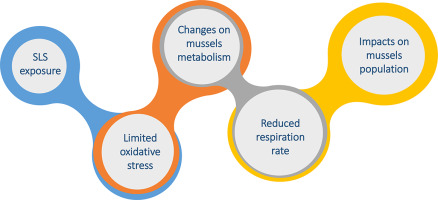当前位置:
X-MOL 学术
›
Comp. Biochem. Physiol. A Mol. Integr. Physiol.
›
论文详情
Our official English website, www.x-mol.net, welcomes your
feedback! (Note: you will need to create a separate account there.)
Toxic impacts induced by Sodium lauryl sulfate in Mytilus galloprovincialis.
Comparative Biochemistry and Physiology A: Molecular & Integrative Physiology ( IF 2.1 ) Pub Date : 2020-01-09 , DOI: 10.1016/j.cbpa.2020.110656 Rosa Freitas 1 , Serena Silvestro 2 , Francesca Coppola 1 , Silvana Costa 1 , Valentina Meucci 3 , Federica Battaglia 3 , Luigi Intorre 3 , Amadeu M V M Soares 1 , Carlo Pretti 4 , Caterina Faggio 5
Comparative Biochemistry and Physiology A: Molecular & Integrative Physiology ( IF 2.1 ) Pub Date : 2020-01-09 , DOI: 10.1016/j.cbpa.2020.110656 Rosa Freitas 1 , Serena Silvestro 2 , Francesca Coppola 1 , Silvana Costa 1 , Valentina Meucci 3 , Federica Battaglia 3 , Luigi Intorre 3 , Amadeu M V M Soares 1 , Carlo Pretti 4 , Caterina Faggio 5
Affiliation

|
Pharmaceuticals and personal care products (PPCPs) are continuously dispersed into the environment, as a result of human and veterinary use, reaching aquatic coastal systems and inhabiting organisms. However, information regarding to toxic effects of these compounds towards marine invertebrates is still scarce, especially in what regards to metabolic capacity and oxidative status alterations induced in bivalves after chronic exposure. In the present study, the toxic impacts of Sodium lauryl sulfate (SLS), an anionic surfactant widely used as an emulsifying cleaning agent in household and cosmetics, were evaluated in the mussel Mytilus galloprovincialis, after exposure for 28 days to different concentrations (0.0; 0.5; 1.0; 2.0 and 4.0 mg/L). For this, effects on mussels respitation rate, metabolic capacity and oxidative status were evaluated. The obtained results indicate a significant decrease on mussel's respiration rate after exposure to different SLS concentrations, an alteration that was accompanied by a decrease of bioconcentration factor along the increasing exposure gradient, especially at the highest exposure concentration. Nonetheless, the amount of SLS accumulated in organisms originated alterations in mussel's metabolic performance, with higher metabolic capacity up to 2.0 mg/L followed by a decrease at the highest tested concentration (4.0 mg/L). Mussels exposed to SLS revealed limited antioxidant defense mecanhisms but cellular damage was only observed at the highest exposure concentration (4.0 mg/L). In fact, up to 2.0 mg/L of SLS limited toxic impacts were observed, namely in terms of oxidative stress and redox balance. However, since mussel's respiration rate was greatly affected by the presence of SLS, the present study may highlight the potential threat of SLS towards marine bivalves, limiting their filtration capacity and, thus, affecting their global physiological development (including growth and reproduction) and ultimely their biochemical performance (afecting their defense capacity towards stressful conditons).
中文翻译:

月桂基硫酸钠引起的盖氏菌病的毒性影响。
由于人类和兽医的使用,药品和个人护理产品(PPCP)不断散布到环境中,到达水生沿海系统和生物栖息地。然而,关于这些化合物对海洋无脊椎动物的毒性作用的信息仍然很少,尤其是关于在慢性暴露后双壳类动物引起的代谢能力和氧化状态改变方面。在本研究中,在贻贝Mytilus galloprovincialis中暴露于不同浓度28天后,评估了广泛用作家庭和化妆品乳化清洁剂的阴离子表面活性剂十二烷基硫酸钠(SLS)的毒性影响(0.0; 0.5; 1.0; 2.0和4.0 mg / L)。为此,评估了对贻贝繁殖率,代谢能力和氧化状态的影响。获得的结果表明,暴露于不同的SLS浓度后,贻贝的呼吸速率显着降低,这种变化伴随着生物浓度因子的降低,尤其是在最高暴露浓度下,随着浓度梯度的增加而降低。尽管如此,生物体中积累的SLS量还是引起贻贝代谢性能的变化,代谢能力高达2.0 mg / L时更高,随后在最高测试浓度(4.0 mg / L)时下降。暴露于SLS的贻贝显示出有限的抗氧化剂防御机制,但仅在最高暴露浓度(4.0 mg / L)时才观察到细胞损伤。实际上,观察到高达2.0 mg / L的SLS有限的毒性影响,即在氧化应激和氧化还原平衡方面。但是,由于贻贝
更新日期:2020-01-09
中文翻译:

月桂基硫酸钠引起的盖氏菌病的毒性影响。
由于人类和兽医的使用,药品和个人护理产品(PPCP)不断散布到环境中,到达水生沿海系统和生物栖息地。然而,关于这些化合物对海洋无脊椎动物的毒性作用的信息仍然很少,尤其是关于在慢性暴露后双壳类动物引起的代谢能力和氧化状态改变方面。在本研究中,在贻贝Mytilus galloprovincialis中暴露于不同浓度28天后,评估了广泛用作家庭和化妆品乳化清洁剂的阴离子表面活性剂十二烷基硫酸钠(SLS)的毒性影响(0.0; 0.5; 1.0; 2.0和4.0 mg / L)。为此,评估了对贻贝繁殖率,代谢能力和氧化状态的影响。获得的结果表明,暴露于不同的SLS浓度后,贻贝的呼吸速率显着降低,这种变化伴随着生物浓度因子的降低,尤其是在最高暴露浓度下,随着浓度梯度的增加而降低。尽管如此,生物体中积累的SLS量还是引起贻贝代谢性能的变化,代谢能力高达2.0 mg / L时更高,随后在最高测试浓度(4.0 mg / L)时下降。暴露于SLS的贻贝显示出有限的抗氧化剂防御机制,但仅在最高暴露浓度(4.0 mg / L)时才观察到细胞损伤。实际上,观察到高达2.0 mg / L的SLS有限的毒性影响,即在氧化应激和氧化还原平衡方面。但是,由于贻贝











































 京公网安备 11010802027423号
京公网安备 11010802027423号